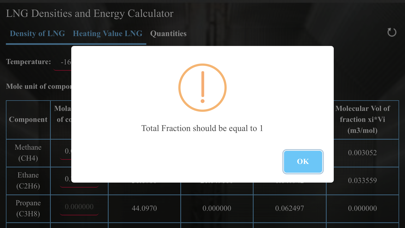
LNG Densities and Energy calc app for iPhone and iPad
Developer: SHIPPING TECHNOLOGIES LTD
First release : 15 Oct 2019
App size: 2.81 Mb
The calculation is conducted based on the information and methodology available in ISO 6976, GIIGNL – LNG Custody Transfer Handbook 3 rd Edition, and Liquefied Gas Handling Principles on Ships and in Terminals 4th Edition (LGHP4).
The gross calorific value (GCV) of gas corresponds to (definition according to ISO 6976) the amount of the heat that would be released by the complete combustion with the oxygen of a specified quantity of gas, in such a way that the pressure p at which the reaction takes place remains constant, and all the products of combustion are returned to the same specified temperature t as that of the reactants,
all of these products being in the gaseous state except for water, which is condensed to the liquid state at t.
The GCV mass is calculated as follows for ideal gases: GCV mass =ΣXi *Mi* Hi / Xi *Mi where: Xi = molar fraction of component i, Hi (mol ) = molar gross calorific value of component i, expressed MJ/kg/mol, Mi = molecular weight of pure component i expressed in kg/mol.
The Wobbe index is calculated using the formula Wi = GCV volume (Hv)
Using the App, in the first tab ‘Density of LNG’ enter the average liquid temperature of the cargo and the mole fractions or mole percentage of the liquid as determined by the Laboratory or as available from the quality certificate, the density will be calculated at that temperature, change the
temperature to obtain the density for any other temperature.
In the next tab ‘Heating value LNG’ the GCV will be automatically calculated for liquid and vapor including the Wobbe Index.
In the last tab ‘Quantities’ if the volume of cargo is entered in m3 then the total energy of the cargo will be calculated, and you can use this data to determine the cargo cost based on unit price.
The App may also be used to verify cargo surveyors figures or for educational purposes.



